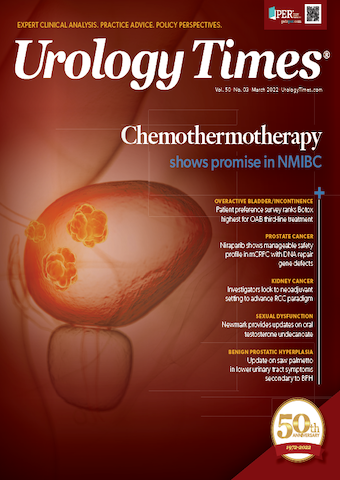Publication
Article
Urology Times Journal
Gender disparities found in bladder cancer trials and real-world systemic therapy use
Author(s):
In a recent study, investigators found that gender disparities exist in clinical trials used to guide National Comprehensive Cancer Network (NCCN) recommendations for urothelial carcinoma (UC). This study was presented at the 2022 Society of Women in Urology Annual Clinical Mentoring Conference.1
Although women make up 30.5% of patients with UC in an administrative database, results showed that only 20% of patients accounted for in the NCCN-cited systemic therapy trials were women.
Padraic O’Malley, MD

“We have to be more mindful and thoughtful about the fact that certain populations are underrepresented in clinical trials, and that’s likely due to a number of factors,” co-author Padraic O’Malley, MD, MSc, FRCSC, clinical assistant professor in University of Florida College of Medicine’s department of Urology, said in an interview with Urology Times®.
To compare the gender proportions among UC clinical trials vs the general US population of UC patients, investigators analyzed Version 1 of the 2021 NCCN guidelines for UC and gathered data from the National Cancer Database (NCDB) program.
Comparisons of gender proportions between the 2 data sets were made using chi-square tests. Univariable and multivariable analysis were also conducted to determine predictors of systemic therapy.
A total of 58,031 patients diagnosed with stage 2 to 4 UC and treated with systemic therapy between 1998 to 2018 were identified from the NCDB, and 31 trials (10,158 patients) that were cited by the NCCN guidelines were reviewed.
Of the UC clinical trials, 7 (22.6%) were US trials, 8 (25.8%) were non-US trials, and 16 (51.6%) were US and non-US trials. Eighteen percent (115/650) of patients in the US trials were women, 21% (544/2630) in the non-US trials were women, and 20% (1361/6878) in the US and non-US trials were women (P = .2168).
The main finding of this study was that significant gender disparities were determined among the trials referenced by the NCCN guideline and that these disparities were based on trial randomization, phase, inclusion of upper tract disease, and type of systemic therapy (chemotherapy vs immunotherapy).
For instance, more advanced trials enrolled a lower percentage of women, which O’Malley referred to as a more ‘nuanced’ finding. Twenty-seven percent (85/317) of patients in phase 1 trials were women, compared with 20% (1141/5819) in phase 3 trials.
In addition, women were significantly less likely to receive systemic therapy (OR 0.93; 95% CI: 0.89-0.96; P < .001) in the NCDB population.
Commenting on the typical barriers of health care that were also observed, O’Malley added, “Those with…lower socioeconomic status [and] African Americans also had lower uptake. So…it’s an internal validation that the sort of disparities we’re seeing are real.”
O’Malley further stressed the need for future research in this topic along with more research in the area of bladder cancer in general: “If people were more mindful of the unmet need of bladder cancer [for] funding for research, that would be an important thing to continue to try and improve in our field.”
“As urologists and as urologic oncologists,” O’Malley concluded, “we have to be more mindful [and] put in extra time and effort to try and optimize [women’s] enrollment to give them the ample opportunity and equal opportunity [so that they can] have access to these…amazing trials that exist nowadays.”
Reference
1. Batra N, Miyagi H, Bozorgmehri S, et al. Gender disparities in the clinical trials and real-world utilization of systemic therapy in the management of urothelial carcinoma. Paper presented at: 2022 Society of Women in Urology Annual Clinical Mentoring Conference; February 7-9, 2022; New Orleans, Louisiana. Poster 6176.

Newsletter
Stay current with the latest urology news and practice-changing insights — sign up now for the essential updates every urologist needs.






























